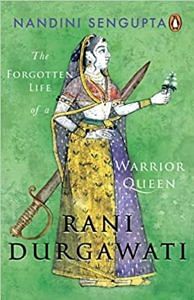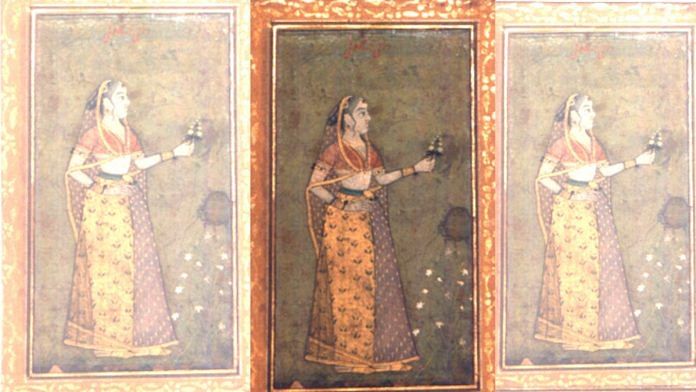Nothing much is known about Durgawati’s childhood and adolescence, and even historical fiction accounts begin the story with her teenage romance. According to a recently discovered horoscope of the queen, she was born on 5 October 1524.1 Durgawati had a sister called Kamlawati, though it is not known whether she was a younger or older sibling.
Even though her patrimony—the tiny kingdom of Rath Mahoba ruled by her father Shalivahan/Salbahan—was nothing to write home about, Durgawati’s accomplishments merited a swayamvar, the ancient Hindu ritual by which royal brides chose their own husband from a collection of guests invited to the event. But the trouble was, Durgawati was in love with a man who was neither Rajput nor a candidate approved by her father. Rath and Mahoba can now be located in UP’s Hamirpur district. Just 80 km to its south was the Gond kingdom of Garha Katanga with its capital in Singorgarh, currently located in Singrampur village of Damoh district, 45 km from Jabalpur city. This land was ruled by Raj Gond king Sangram Shah, whose older son and heir Dalpati/Dalpat Shah was the man Durgawati had lost her heart to.
Where and how did the young princess meet her prince charming? There are various local tales that have been quoted by both historians and writers. Well-known litterateur Vrindavan Lal Varma, author of the 1960s cult classic Maharani Durgawati, shows the two lovers meeting first at the Mania Devi temple in Mahoba and later on a return-invite hunt near Kalinjar Fort. This hunt-romance, though comes with a confusing thread. Historians like R.V. Russel and Rai Bahadur Hiralal say that it was ‘Chandel Raja Keerat Singh’ who was out ‘hunting at Maniagarh with the Gond Raja of Garha Mandla’. Given that Keerat Singh is often confused as Durgawati’s father, this reference may be apocryphal. But there is no doubt the lovers met in secret, and out of such clandestine meetings was born a love story that continues to live on in bard song to this day.
Also read: ‘Indians never invaded’ is a myth. Guptas, Cholas, Lalitaditya Muktapida were conquerors
Local folk traditions still remember this romance as much as the queen’s final sacrifice. The song Maa Veerangana Durgawati Maharani by Gond folk singer Ramkumar Dhruva, for example, talks of both incidents one after the other. ‘Garh Mandla ke Dalpati Raja preme piyari lagayi/ Bade pratapi raja they weh Durga se shaadi rachayi/Mughalo se woh ladi larai kabhi har na mani/ lartay lartay Narai Nala pahuch gayee’ (‘Garha Mandla’s Dalpati Raja was madly in love/He was a powerful king and he married Durga/She fought against the Mughals and refused to give up/She reached Narai Nala still fighting off the threat’). Indeed, every folk tradition about Durgawati mentions coeur et courage in the same breath.
In folk memory, the Gond queen is remembered both for love and war. Even as she dreamt of her prince charming, the teenage Durgawati knew how impossible their love was. As a Rajput and a princess, she understood only too well what was expected of her. She had to choose her husband from among the guests approved and invited by her father. Unfortunately, she also knew that the man she really wanted to marry would certainly not be invited to the swayamvar. Although good-looking, courageous and the crown prince of a powerful neighbouring kingdom, Dalpati or Dalpat Shah was Gond, not Rajput. His father Sangram Shah had approved the match, but Shalivahan was not interested. Sleeman describes the situation in his inimitable style. Overtures had been made for a union between Dulput Sa [Dalpati Shah] and Durghoutee [Durgawati], the daughter of the raja of Mahoba, who was much celebrated for her singular beauty; but the proposal was rejected on the ground of a previous engagement, and some inferiority of caste on the part of the Gurha family. Parental disapproval notwithstanding, there was good reason for Durgawati to be smitten.
The Gond crown prince was an exceptionally good-looking man, and he was the scion of what was then the largest and most powerful kingdom in central India. While royal panegyrics are never short of hyperbole, in the case of Dalpati and Durgawati, their beauty is something all chroniclers, contemporary and otherwise, invariably mention. In contemporary references, literary chronicles and bard song, Dalpati Shah is as celebrated for his looks as Durgawati herself.
Also read: Turks weren’t barbarians. They appreciated Hindu temple architecture
Anant Dixit, a sixteenth century poet who was Dalpati Shah’s contemporary, says the Gond prince was ‘Madan sadrisha roop’ or as handsome as Madan, the god of love himself. He mentions this while describing Dalpati and Durga in the Gadhesh Nrpa Varnan Samagrah Slokah, an anthology of Sanskrit poems compiled in the sixteenth century. Durgawati is similarly called ‘sundari’. Sleeman describes Dalpati Shah’s ‘appearance’ with characteristic romantic flourish. ‘Dulput Sa (Dalpati Shah),’ he writes, ‘was a man of uncommonly fine appearance and this, added to the celebrity of his father’s name and extent of his dominion, made Durghoutee (Durgawati) as desirous as himself for the union.’ For his part, Dalpati would have undoubtedly heard of the feisty Chandel princess whose beauty nearly every contemporary chronicler talked about, right from Abul Fazl to Badauni and Ferishta to Anant Dixit.
Indeed, a century after her death, the Ramnagar inscription on Raj Gond genealogy remembered Durgawati as the very embodiment of Goddess Lakshmi. ‘His [Dalpati Shah] consort Durgawati was as prosperity itself to the fortunes of petitioners, beautiful as the image of virtue, the boundary of the good fortune of this earth.’ Clearly, Dalpati and Durga made a fine couple indeed. Because of Shalivahan’s refusal to accept a Raj Gond sonin-law, the two lovers devised a plan to elope. Literary sources and folk traditions say Durgawati sent word to her prince to come and get her. Although this would have been unusual in the strictly regimented medieval world she inhabited, in using the age-old tradition of harana vivah (where the bride invites a champion to fight for her hand), the princess was merely taking a cue from the option used by other gutsy women before her like Subhadra and Rukmini in the Mahabharat and Sanyogita in the twelfth century.
 This excerpt from ‘Rani Durgawati: The Forgotten Life of a Warrior Queen’ by Nandini Sengupta has been published with permission from Penguin India.
This excerpt from ‘Rani Durgawati: The Forgotten Life of a Warrior Queen’ by Nandini Sengupta has been published with permission from Penguin India.



